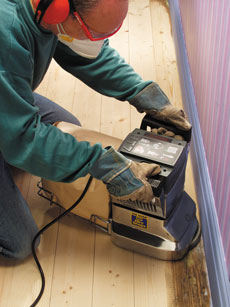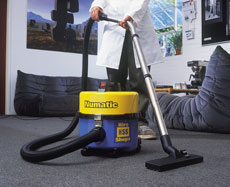-
Tool Hire
Access & Powered Access Breaking & Drilling Building & Siteworks Carpet Cleaners Cleaning & Floorcare Concreting & Preparation Cooling, Heating, Drying Event Fixing Tools Gardening Ladders Lifting & Handling Lighting & Power Painting & Decorating Plumbing & Pumping Powered Access Safety & Ventilation Sanders Sawing & Cutting Skip Hire Surveying & Location Welding Hilti Products
- Find a Branch
- Tips & Advice
- FAQ
- Contact Us
Home How to Sand a Floor
Having authentic wooden floors is a great way to add both warmth and character to any room. By stripping away old paint and dirt, you can create a great look at a fraction of the cost of buying new flooring.
Click on the videos below to see the Floor and Edging Sanders in action.
Step 1
If you are having trouble viewing this video please click here
First, be sure to clear away all furniture and fragile items from the room, including curtains and soft furnishings. Also tape up doors and cupboards if they cannot be moved to prevent the wood dust getting in. Ensure you are wearing the correct breathing apparatus and protective clothing required for the task.
Step 2
Ensure the flooring is completely clear and any loose nails or potential hazards are removed. You can knock protruding nails well beneath the woods surface to prevent the floor sanding paper from tearing.
Step 3
Tidy up the wood panels before starting to sand, by making any necessary repairs to the panels and giving the floor a good sweep and vacuuming.
Step 4
If you are having trouble viewing this video please click here
Be sure to read the manual for the floor sander before starting any work. Load the floor sander with the appropriate sanding sheet, ensuring that it remains tight against the drum to prevent slipping.
Step 5
Position the floor sander against one wall, with over half of the remaining floor in front of you. Keep the sanding drum elevated, and as you start to move forward with the machine gradually lower the sanding drum onto the wood flooring to start sanding. Be sure to sand with the grain.
Step 6
Keep moving forward at a gradual pace, until you reach the end of the room. At this stage, lift the drum off the floor and turn around, ready to repeat the same procedure over the same area of flooring.
Step 7
When you have completed one pass, reposition the sander around 7cm across from the first area and repeat the process. Gradually you will reach the opposite side of the room, go over each pass evenly and carefully.
Step 8
Turn off the belt sander and work on neatening up the corners and small areas not reached by the drum sander. Do this by using an edge sander; you can blend the two sanded areas together by a using semi-circular motion with the edge sander as you work towards the corners of the room.
Varnishing
If you are looking for a rich varnished style or even a “freshly sanded” look, it would always be recommended to finish the flooring with a varnish. This varnish will help to seal and protect the floor the stains, marks and damage from spills.
Step 9
For a classic rich finish, always go for a quality varnish. We would recommend Ronseal Diamond Hard Floor Finish for best results. Before applying the varnish however, it is always recommended to give the floor a vacuum to remove any dust and debris, which could become stuck in the varnish.
Step 10
When applying the varnish to the floor, be sure to keep the room well ventilated, by opening doors and windows and even wearing a mask if possible. Begin applying the varnish with a wide brush in even strokes, which follow the grain of the wood.
Step 11
Repeat the varnishing process across the whole floor, with at least 2 hours drying time between each coat. A minimum of 3 coats are recommended to give the floor maximum shine and protection.
Step 12
Allow the floor to fully dry. At least 8 hours after the final coat is applied is recommended. Allow at least 72 hours drying time if the floor will be heavily used.







